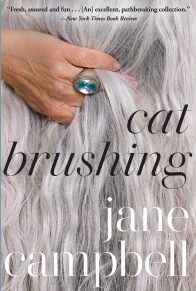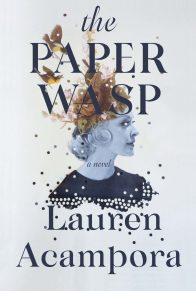“Questions of the pursuit of art, stagnation, youth and aging, and how to exist on a planet that is, increasingly, made up solely of emergencies, are grounded in the richness (no pun intended) of Sylvie and Louisa’s characters. And, as in The Paper Wasp, Acampora’s descriptions of the strangeness of artworks are not to be missed.”—Lit Hub, Best Summer Reads
“A thrilling drama… As Gabriel draws both Louisa and Sylvie into his thrall, their lush small town stops feeling quite so staid.”—Vogue
“In the tradition of territory-marking novelists John Cheever and John Updike, Lauren Acampora expertly captures deep-pocketed suburban restlessness in The Hundred Waters… Through its delicate narrative circuitry and roving point of view, the novel gradually exposes a community that’s in crisis without even knowing it.”—Shelf Awareness, starred review
“In this tightly paced novel that echoes Celeste Ng’s Little Fires Everywhere (2017), Tom Perrotta’s Mrs. Fletcher (2017), and A. Natasha Joukovsky’s The Portrait of a Mirror (2021), Acampora sets the idealism of youth against middle-age complacency and high-society reservations… With this gem of a novel, Acampora cements herself as a thrilling voice in fiction.”—Booklist, starred review
“Arresting… Acampora achieves a sharp and tense depiction of an illusory and stultifying haven.”—Publishers Weekly
“Acampora weaves a tale of artistic ambition, climate activism, and the seductive allure of extravagant wealth. Told in the author’s signature lush prose… this is an enchanting pool worth sticking your toe into.”—Kirkus Reviews
“With a fluid writing style and a plot that moves along quickly… Absorbing… Excellent.”—Library Journal (starred review)
Praise for The Paper Wasp:
“Take The Talented Mr. Ripley, cross it with Suspiria, add a dash of La La Land and mix it all at midnight and this arty psychological stalker novel is what might result.”—New York Times Book Review
“A hypnotic tale of codependence that skewers our fascination with gossip and fame.”—O Magazine, “The Best Books by Women of Summer 2019”
“The Paper Wasp fixes its gaze on one magnetic and increasingly twisted friendship… hypnotic and sensual… Acampora’s prose has a seductive, pearlescent allure.”—TIME Magazine
“Acampora’s kaleidoscopic narrative shifts fluidly from Abby’s strange, shimmering images to Elise’s descent into tabloid erasure, artfully tracking the unexpected power shift between them.”—BBC.com
“Gripping… likely to buzz its way into many beach bags this summer.”—Irish Times
“A thrilling tale of a twisted friendship, obsession and ambition… an unsettling, compelling read.”—Tatler
“Landing somewhere in between Marisha Pessl’s Night Film and You by Caroline Kepnes, The Paper Wasp aims to disturb while it enraptures.”—Open Letters Review
“Readers will enjoy reading this story of dark friendship set against the ‘flash of Hollywood.’”—Boston.com
“This is the Los Angeles of weird cults and day-drunk stars, of struggling documentary filmmakers and mysterious but powerful directors… Utterly bizarre and completely bewitching, this twisted, delicious tale will grab you from the first page and hurl you over the edge.”—Kirkus Reviews (starred review)
“Acampora’s linked short story collection, The Wonder Garden, electrified literary critics, and this deeply disturbing, wildly inventive, and completely unpredictable debut novel is sure to do the same. Abby and Elise will be haunting readers’ dreams long after the last page.”—Library Journal (starred review)
“An unsettling and surreal excavation of the boundless depths of the human psyche… Acampora’s writing is gorgeous and renders with precision and clarity the spiral of Abby’s increasingly disorienting world of obsession and hallucinatory imagery. The result is a piercing, disquieting novel.”—Publishers Weekly
“It seems at first a novel of friendship between women—a rich vein for any writer—but in The Paper Wasp, Lauren Acampora upends convention, creating an unsettling (and impossible to put down) story about art and ambition, fame and power. A beautiful and surprising book.”—Rumaan Alam, author of That Kind of Mother
“Acampora is an exquisite stylist who misses no shade or psychological texture and who also plumbs depths of feeling in note-perfect prose that leaves one stunned at the artistry on display. The Paper Wasp is a powerful statement of aesthetic purpose, and an unalloyed triumph.”—Matthew Thomas, author of We Are Not Ourselves
“A lyrical, provocative, imaginative page turner that makes the world feel new again, The Paper Wasp is both a stunning portrait of a fixated woman and an addictive, modern commentary on an eternal theme of obsession. In her glittering, goosebump-inducing prose, Lauren Acampora gives us a soul trip/head trip/rarefied LA trip replete with surrealism and social commentary.”—Caroline Kepnes, author of You
“The Paper Wasp was a crazy joyride of a novel; a bold and joyous take on female friendship, outsider ambition and the secret powers of loners. It gives us a heroine who is selfish, weird, manipulative, and sometimes just plain nasty, and makes us root for her with all our selfish, weird, manipulative, and nasty hearts. I loved every second of it.”—Sandra Newman, author of The Heavens
















